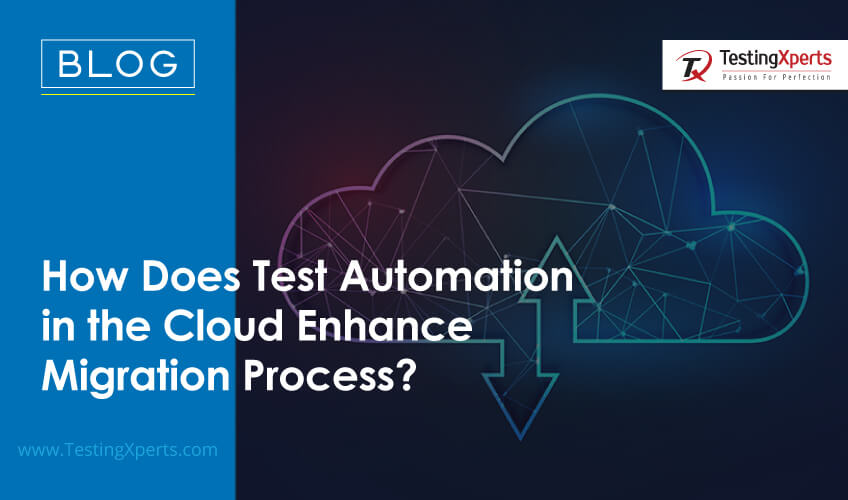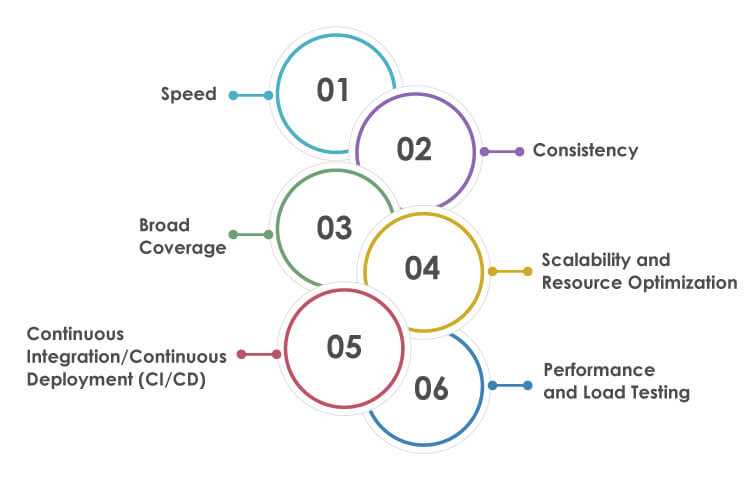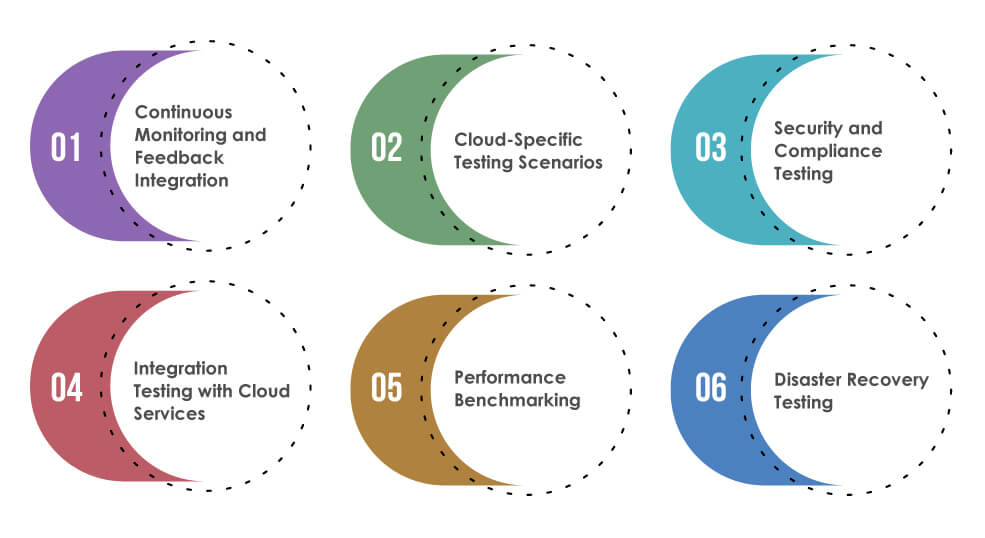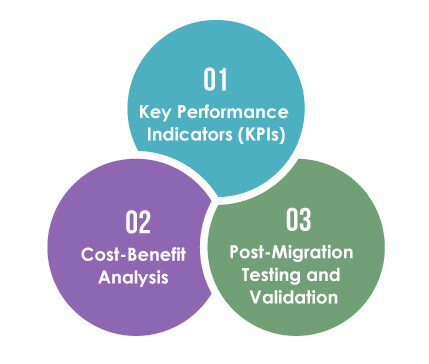Recommended Blogs
How Does Test Automation in the Cloud Enhance Migration Process?

- What is Cloud Migration
- What Should Be on Your Cloud Migration Readiness Checklist?
- How Can AI and ML Improve Cloud Migration and Optimization?
- Benefits of Automating Tests
- Test Automation Best Practices for Cloud Migration
- What Security and Compliance Considerations Should You Prioritize?
- How Can AI and ML Improve Cloud Migration and Optimization?
- Measuring the Impact of Test Automation
- Conclusion
- Why Partner with TestingXperts for Cloud Migration Testing Automation?
In the digital era, cloud migration is a strategic step for businesses seeking growth, innovation, and operational efficiency. This transformative process involves transferring digital assets from on-premises infrastructure to cloud environments, offering numerous benefits such as scalability, cost reduction, sharing resources, enhanced collaboration, and improved accessibility.
However, this process is not without its challenges. Cloud migration can be costly and complex if not executed correctly, especially for legacy line-of-business applications. Test automation in the cloud minimizes disruption to core business processes and maintains data integrity throughout the migration. It’s a strategic tool to ensure successful, cost-effective cloud migration.
As organizations increasingly adopt hybrid and multi-cloud strategies, leveraging the services of different cloud providers, the role of test automation in facilitating a smooth, efficient migration process becomes even more evident.
What is Cloud Migration?
Cloud migration involves moving various components of a business’s IT infrastructure, like databases, applications, and IT processes, from an organization’s computers to the cloud. It is a strategic step for companies looking to improve their flexibility in operations, cut down on the overhead costs associated with physical data centers, and take advantage of the cloud’s ability to scale resources up or down as needed. The migration to cloud computing is crucial for businesses to adapt to market demands quickly and with greater efficiency.

The following are the phases involved in the cloud migration process
Planning and Assessment
This initial stage thoroughly evaluates the organization’s infrastructure, applications, and data to determine what will move to the cloud. Decisions are made regarding which cloud services models (IaaS, PaaS, SaaS) and deployment models (public, private, hybrid) are most suitable. This phase sets the foundation for a successful migration by outlining objectives, costs, and potential risks.
Proof of Concept
Organizations often run a pilot project as proof of concept before a full-scale migration. This smaller, controlled test allows the IT team to validate the migration plan, uncover potential issues, and assess the performance of applications in the cloud environment. It’s a low-risk way to measure the effectiveness of the migration strategy.
Data Migration
Data is crucial for businesses, and migrating it securely is essential. During this phase, data is transferred to the cloud. The process must ensure data integrity, security, and minimal downtime. Tools and services for automated data migration can be utilized to streamline this process, making it more efficient and reliable.
Application Migration
Applications may require modifications to run optimally in the cloud. This step can involve simple ‘lift-and-shift’ approaches for less complex applications or more extensive re-platforming or re-architecting for others. The goal is to ensure that applications leverage cloud-native features and are scalable, resilient, and cost-effective.
Optimization
Post-migration, the focus shifts to optimization. This ongoing process involves monitoring and managing the cloud environment to improve performance and reduce costs. Companies must continuously evaluate cloud usage and adjust resources to align with demand, ensuring operational efficiency and cost management.
What Should Be on Your Cloud Migration Readiness Checklist?
A clear checklist helps ensure business goals are aligned, technical gaps are addressed, and migration risks are reduced. This is what you should do.
Align Business Goals
Ensure the migration supports business goals like scalability, speed, cost-efficiency or innovation. Moving without a plan loses money and creates uncertainty inside the organisation.
Current Infrastructure Audit
Look at the systems, servers and applications already in place. Find out what’s old, unnecessary or doesn’t work with your cloud destination.
Application Dependency Mapping
Learn how apps work together. This helps keep workflows from breaking and prevents downtime during migration.
Data Sensitivity and Compliance Needs
Organise your data by how sensitive it is. Set rules for what data can go to the cloud, what needs to be encrypted and what must stay on-premises because of laws like HIPAA or GDPR.
The Role of Test Automation in Cloud Migration
Test automation significantly enhances the cloud migration process. It addresses the limitations of manual testing, which is often slow and prone to errors and does not scale with complex or large applications, especially when dealing with today’s businesses’ vast and complex systems.
Challenges in Manual Testing for Cloud Migration
• Manually running each test case is a lengthy process, which prolongs the overall migration timeline.
• The complexity of cloud infrastructures amplifies the chance of oversights when tests are conducted manually.
• Manual methods are inadequate for the vast number of tests required in cloud migration such as performance and stress testing, leading to bottleneck issues.
• It’s challenging to manually test every scenario, leading to potential gaps in coverage. Also, repetitive manual testing is not reliable and prone to human errors or mistakes.
• Manual testing requires many human resources, which can be costly and inefficient.
Benefits of Implementing Test Automation
Automated testing brings speed, accuracy, and the ability to scale up to meet the demands of large-scale migrations. It ensures the migration is faster and more reliable by systematically verifying each step and providing continuous feedback. Following are some of the benefits of automating tests for cloud migration

Speed
Automation allows for the rapid execution of test cases, significantly decreasing the time needed to perform thorough testing. This quick turnaround is crucial for meeting tight migration schedules and reducing downtime.
Consistency
Automated tests continuously deliver the same conditions and inputs, providing consistent results. This reliability is essential for accurately comparing system performance before and after cloud migration.
Broad Coverage
Automation can run countless test scenarios in a fraction of the time it takes manually. This thorough testing ensures that every aspect of the system is evaluated, leading to a robust cloud environment post-migration.
Scalability and Resource Optimisation
As the cloud environment expands, test automation can be scaled accordingly without a corresponding increase in effort or resources, unlike manual testing, which does not scale linearly. Test automation allows human resources to be reallocated to tasks that require creative and strategic thinking, such as analysing test results for insights or improving the customer experience.
Continuous Integration/Continuous Deployment (CI/CD)
Automated testing is integral to CI/CD pipelines, facilitating regular updates and ensuring that new features are tested and deployed efficiently. It can also run frequently throughout the cloud migration process, which is achievable through automation, helping to identify and rectify issues quickly. This proactive approach can prevent minor problems from becoming larger ones down the line.
Performance and Load Testing
Automated tools can simulate high volumes of users and complex transactions to stress-test systems, ensuring that performance benchmarks are met and that the system can handle the expected load in the cloud.
Test Automation Best Practices for Cloud Migration
Incorporating best practices in test automation is crucial for a successful cloud migration. It ensures both efficiency and effectiveness during the migration and a stable and robust cloud environment post-transition. These practices guide the selection of appropriate techniques, manage the complexities of test data, and address the need for scalable and maintainable test scripts.

Continuous Monitoring and Feedback Integration
This involves setting up automated monitoring tools that track the performance and health of applications throughout cloud migration. It ensures any deviations from expected behavior are caught and addressed promptly. Integrating feedback mechanisms also allows continuous improvement of the migration process and the migrated applications.
Cloud-Specific Testing Scenarios
Tailoring test cases to the cloud means verifying that applications can effectively utilize cloud-native features such as scaling, managed services, and distributed databases. Testing how an application behaves in the dynamic cloud environment under different load conditions and failure scenarios is crucial.
Security and Compliance Testing
With the cloud’s shared responsibility model, automated tests must include security compliance checks to ensure the application adheres to relevant regulations and industry standards. This also involves testing for data protection, access controls, and encryption standards specific to cloud architectures.
Integration Testing with Cloud Services
As applications often rely on a range of cloud services post-migration, integration testing ensures that all connections between the application and these services work flawlessly. This includes validating communication with cloud databases’ third-party APIs and ensuring that microservices interact as expected.
Performance Benchmarking
This practice entails measuring application performance against defined criteria before and after migration. It helps confirm that the cloud infrastructure supports the application’s needs and identifies areas where performance tuning may be necessary.
Disaster Recovery Testing
Automating disaster recovery tests ensures that an application’s backup and restore functions will work correctly during a system outage. This includes testing backup schedules, data integrity upon restoration, and the failover to standby systems to guarantee minimal downtime.
What Security and Compliance Considerations Should You Prioritize?
Moving to the cloud without considering security and compliance might put your data at risk and leave you open to legal action. You need to plan not just for a successful move but also for keeping security standards high.
Data Protection Responsibilities
Know what your cloud provider is responsible for and what you are. Cloud providers usually take care of the infrastructure security but you are still responsible for app-level and data-level security.
Encryption and Access Controls
Encrypt sensitive data when not in use and when in transit. Use role-based access controls to limit who can see, change or manage data before, during and after the migration.
Regulatory Compliance
Depending on your industry and where your data is stored, ensure your cloud plan follows the rules set by GDPR, HIPAA, SOC 2 or ISO 27001.
Automated Compliance Checks
Automated testing is a good way to ensure security policies are followed especially when there are many changes or CI/CD pipelines.
Incident Response Readiness
Test your disaster and incident response plans often. Make sure they consider cloud-specific scenarios like service outages or region-to-region issues.
How Can AI and ML Improve Cloud Migration and Optimisation?
AI and ML are not just terms you mention to seem smart; they can actually help you plan and execute your cloud migration better.
Here’s how.
AI-Driven Workload Analysis and Migration Planning
To show the best migration options, AI tools can analyze the performance of an application, its requirements, how it’s used and the infrastructure characteristics. This is to prevent poor utilization of cloud services or moving cases that are too small.
ML-Based Cost Optimization and Forecasting
Machine learning models can detect abnormal usage patterns, forecast resource consumption and suggest how to scale instances. Such learnings reduce cloud spend and match the cloud infrastructure to usage.
Anomaly Detection in Real-Time
Monitoring with AI tools can provide alerts on performance issues during and after a migration or unusual behavior. Prevention allows problems to be fixed faster resulting to less downtime.
Self-Healing Systems
The AI frameworks can be tuned to auto-remediate issues like restart failed services, redirect traffic or autoscale resources based on load.
Measuring the Impact of Test Automation
Measuring the impact of test automation on cloud migration is a critical step in understanding its value. It involves analysing various factors that contribute to the overall success of the migration process. Businesses can understand their test automation efforts’ efficiency, effectiveness, and financial impact. These measures justify the investment in test automation and guide future improvements to the migration strategy.

Key Performance Indicators (KPIs)
These are the metrics that track and measure the efficiency and effectiveness of test automation. Common KPIs include test coverage, defect detection rate, time to test, and the number of test cases executed within a cycle. Monitoring these can help determine how well test automation supports cloud migration.
Cost-Benefit Analysis
This financial assessment weighs the initial and ongoing costs of implementing automated testing against the savings and advantages it provides. Factors include reduced manual labor, decreased downtime, and the value of faster time-to-market. A well-structured analysis will reveal test automation’s return on investment (ROI).
Post-Migration Testing and Validation
After migrating to the cloud, it is crucial to continue testing to validate the performance and functionality of the system in its new environment. This includes checking that all systems operate correctly, maintaining data integrity, and that the cloud infrastructure supports the application’s scalability and security requirements.
Conclusion
Test automation significantly enhances cloud migration by introducing efficiency, ensuring consistency, and enabling extensive coverage. The strategic implementation of automated testing can lead to substantial cost savings, improved resource utilization, and a smoother transition to cloud testing services. Ultimately, automation is a cornerstone in modernizing IT infrastructure, offering a clear path to reaping the benefits of cloud technology. By implementing these automated processes, businesses can navigate the complexities of cloud migration with greater confidence and success, positioning themselves for ongoing innovation and competitiveness in the digital marketplace.
Why Partner with Tx for Cloud Migration Testing Automation?
Choosing Tx for your cloud migration testing automation needs ensures you get access to advanced technical solutions, innovative strategies, and customer-centric processes. Our unique approach to cloud migration testing automation ensures that your migration to the cloud is smooth, secure, and strategically advantageous. By partnering with Tx, you get
• A team of certified professionals who are experts in test automation and cloud technologies.
• Our automation solutions leverage AI and machine learning to predict and prevent potential issues before they impact your migration.
• Our security protocols are designed to meet the highest standards, protecting your business against evolving threats.
• Our flexible frameworks can be adapted to your specific cloud architecture, providing a personalised service that many competitors simply cannot match.
• Ongoing monitoring and optimisation to ensure your cloud environment is stable and continually improving performance and efficiency.
• The in-house accelerator, Tx-Automate, enables tool-agnostic automation for functional and regression testing, enabling early test script development within the SDLC and minimising the need for specialised testing skills.
To know more, contact our test automation experts now.
Discover more
